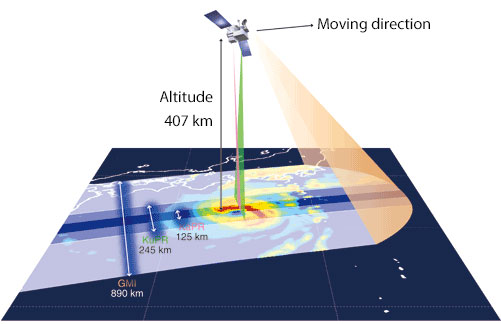Overview of the GPM Core Observatory
The GPM core observatory was jointly developed by Japan and the U.S. Two observation instruments are onboard the core observatory. One is the Dual-frequency Precipitation Radar (DPR) developed by Japan, and the other is the GPM Microwave Imager (GPM) developed by the U.S.
The GPM core observatory will be able to observe not only the tropical zone but also mid to high latitude areas by having an orbit inclination of 65 degrees. In addition, with its non-sun-synchronous orbit, it can capture changes in precipitation in one day.
The DPR is a successor of the Precipitation Radar (PR) loaded onto the GPM’s predecessor, the Tropical Rainfall Measuring Mission (TRMM.) The 35.5 GHz radar was additionally installed onto the PR at 13.6 GHz for high accuracy observation. The GMI is also a successor of the TRMM’s microwave imager (TMI) with four additional high-frequency channels (on 166 GHz and 183 GHz) in addition to the TMI’s nine frequency bands.
The DPR’s swath width is about 245 km for the 13.6 GHz radar, and about 125 km for the 35.5 GHz radar. The two radars will synchronously work when their scanning swaths are overlapped. On the other hand, the GMI will perform conical-scanning and its swath width is about 900 km.
The core observatory’s role is to improve its precipitation observation accuracy for microwave imagers on a constellation of satellites by simultaneously conducting observations with the radar and the microwave imager.

